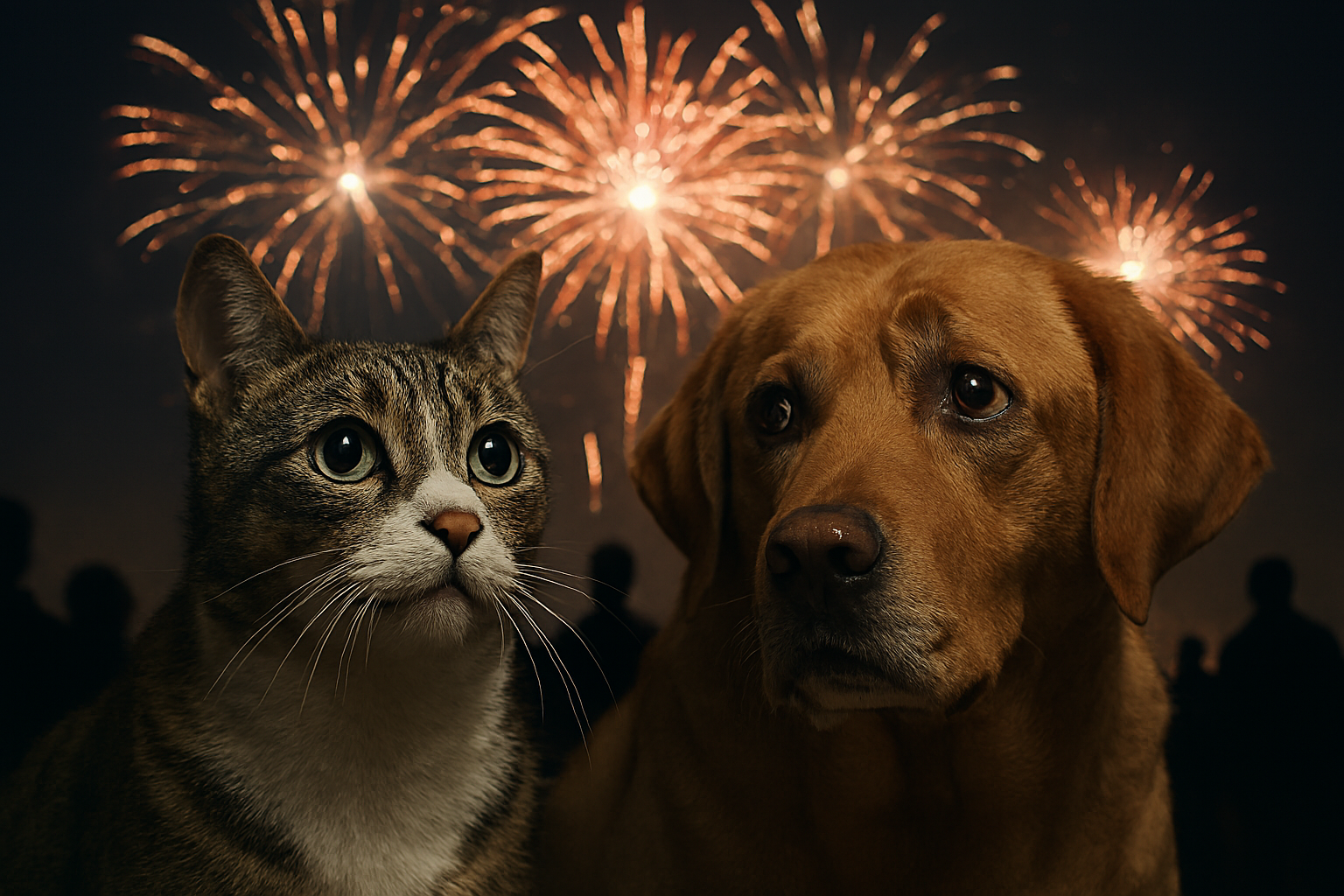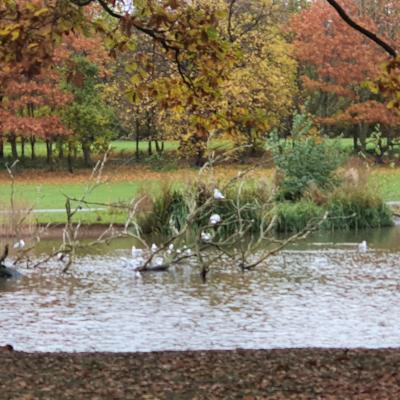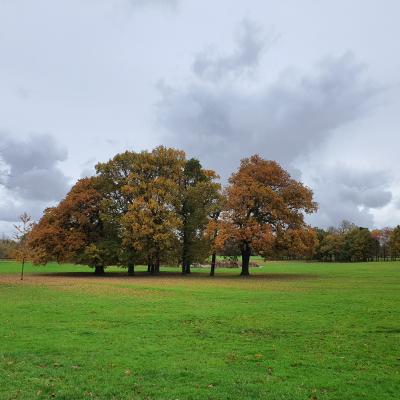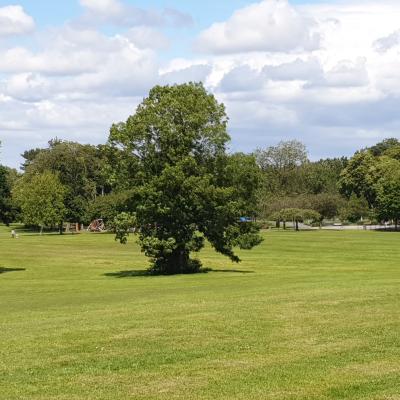
Fireworks and Animals: A Guide to Reducing Stress and Protecting Pets
Fireworks are a cherished part of British celebration culture—from Bonfire Night and New Year’s Eve to Diwali, weddings, and local festivals. But for animals, these dazzling displays can be deeply distressing. The sudden bangs, flashing lights, and acrid smells trigger fear responses that can lead to panic, injury, and long-term behavioural issues.
This guide explores the impact of fireworks on domestic pets, livestock, and wildlife, and offers detailed, evidence-based strategies for keeping animals safe. It also includes a robust section on desensitisation and sound training—a proactive approach to reducing fear before fireworks begin.
Section 1: Why Fireworks Distress Animals
Sensory Overload
Animals experience the world differently from humans. Their hearing is more acute, their sense of smell more sensitive, and their understanding of human events non-existent. Fireworks introduce:
- Sudden, high-decibel noise: Dogs can hear frequencies up to 45,000 Hz (humans max out at 20,000 Hz), making bangs and whistles overwhelming.
- Bright, unpredictable flashes: Cats and dogs are sensitive to light changes, and flashes can trigger a startle reflex.
- Vibrations and smells: The chemical scent of fireworks and ground tremors can heighten anxiety.
Psychological Impact
- Fight-or-flight response: Loud noises activate the amygdala, triggering adrenaline and cortisol release.
- Conditioned fear: Pets may associate certain times of year or sounds with trauma, leading to anticipatory anxiety.
- Long-term phobias: Repeated exposure without support can lead to noise phobia, a clinical condition requiring behavioural intervention.
Section 2: Common Reactions by Species
Dogs
- Trembling, panting, pacing
- Barking or whining
- Hiding or attempting escape
- Destructive behaviour
- Loss of bladder or bowel control
Cats
- Fleeing or freezing
- Hiding in inaccessible places
- Aggression or withdrawal
- Refusal to eat or drink
- Over-grooming or vocalising
Rabbits, Guinea Pigs, Birds
- Panic and erratic movement
- Injuries from thrashing or fleeing
- Refusal to eat
- Heart failure in extreme cases
Horses and Livestock
- Bolting or crashing into fences
- Injuries to themselves or handlers
- Refusal to enter stables
- Disruption of feeding and sleep patterns
Wildlife
- Nest abandonment
- Disorientation and collisions
- Increased road fatalities
- Bonfire-related injuries (especially hedgehogs)
Section 3: Immediate Safety Measures
For Dogs and Cats
- Create a safe zone: A quiet room with blankets, toys, and familiar scents. Let them hide if they choose.
- Close windows and curtains: Reduces noise and light exposure.
- Play calming sounds: Classical music, white noise, or pet-specific playlists.
- Stay calm yourself: Avoid fussing or punishment. Your demeanour sets the tone.
- Walk dogs early: Before dusk to avoid exposure.
- Microchip and ID tags: Ensure they’re up to date in case of escape.
- Use calming aids: Pheromone diffusers (Adaptil, Feliway), anxiety wraps, or vet-prescribed medication.
For Small Pets
- Bring hutches indoors: Or cover with thick blankets, leaving ventilation.
- Add extra bedding: Encourages burrowing and security.
- Move cages away from windows: Reduces exposure to light and sound.
For Horses and Livestock
- Stable animals if possible: In familiar surroundings.
- Secure fencing and gates: Prevent escape.
- Check local display schedules: Alert neighbours and organisers.
- Keep lighting consistent: Sudden changes can increase stress.
For Wildlife-Friendly Gardens
- Check bonfires before lighting: Hedgehogs often nest in wood piles.
- Limit firework debris: Clean up promptly.
- Avoid loud fireworks near habitats: Consider silent alternatives.
Section 4: Desensitisation and Sound Training
What Is Desensitisation?
Desensitisation is a behavioural technique that gradually exposes animals to a feared stimulus—in this case, firework sounds—at low intensity, helping them build tolerance. When paired with counter-conditioning (rewarding calm behaviour), it can significantly reduce anxiety.
Why It Works
- Rewires the fear response: Repeated exposure without threat teaches the brain that the sound is safe.
- Builds resilience: Pets learn to stay calm even when startled.
- Improves quality of life: Reduces stress during fireworks, thunderstorms, and other loud events.
Step-by-Step Guide for Dogs and Cats
-
Choose a trusted sound source
Use professionally designed tracks like Sounds Scary (Dogs Trust) or Sound Therapy 4 Pets. Avoid random YouTube clips. -
Start at a very low volume
Play the sound while your pet is relaxed—during feeding or play. It should be barely audible. -
Pair with positive reinforcement
Offer treats, toys, or affection while the sound plays. This builds a positive association. -
Gradually increase volume
Only raise the volume when your pet shows no signs of stress. If they react negatively, lower it and try again later. -
Keep sessions short and positive
Five to ten minutes is ideal. End on a calm note. -
Practice regularly
Daily sessions over several weeks are most effective. Begin in early autumn to prepare for Bonfire Night. -
Use calming aids alongside training
Pheromone diffusers, anxiety wraps, or vet-approved supplements can support progress. -
Avoid flooding
Never expose your pet to loud fireworks in hopes they’ll “get used to it.” This can worsen fear and cause trauma.
For Severe Cases
- Consult a qualified behaviourist
Look for APBC or CCAB-accredited professionals. - Consider medication
Vets may prescribe short-term anti-anxiety medication for firework season. - Use video monitoring
Track progress and identify stress signals during training.
Section 5: Community Action and Outreach
What Individuals Can Do
- Share local display dates with neighbours.
- Encourage use of silent or low-noise fireworks.
- Offer support to vulnerable pet owners—check on pets, share calming tips, or help with temporary housing.
- Report misuse of fireworks (outside legal hours) to local authorities or via 101.
What Councils and Schools Can Do
- Promote firework safety campaigns in newsletters and social media.
- Distribute flyers with pet safety tips and desensitisation guides.
- Host community Q&A sessions with vets or behaviourists.
- Encourage organisers to notify residents of upcoming displays.
What Event Organisers Can Do
- Use silent fireworks or laser shows.
- Schedule displays early in the evening.
- Notify nearby residents and farms well in advance.
- Provide helplines or support for pet owners.
Section 6: Legal and Ethical Considerations
UK Firework Laws
- Fireworks must not be set off between 11pm and 7am (exceptions: Bonfire Night until midnight, New Year’s Eve, Diwali, Chinese New Year until 1am).
- Illegal use can be reported to the police or local council.
- Retailers must not sell fireworks to anyone under 18.
Ethical Use
- Consider the impact on pets, wildlife, veterans, and neurodivergent individuals.
- Choose low-noise or silent fireworks.
- Avoid displays near animal habitats or care homes.
Section 7: Resources and Support
National Organisations
- Dogs Trust – Free desensitisation programmes and advice
- RSPCA – Firework safety tips and behavioural support
- Blue Cross – Guides on noise phobia and calming techniques
- British Veterinary Association – Professional advice and medication options
Teesside-Specific Contacts
- Local Vets – Many offer firework preparation clinics
- Middlesbrough Council – Report misuse or request community support
- Neighbourhood Watch Groups – Share display dates and safety tips
- Community Centres – Host outreach events or distribute flyers
Fireworks are a tradition—but they don’t have to come at the cost of animal welfare. Through preparation, desensitisation, and community awareness, we can make celebration season safer for every creature. Whether you're a pet owner, event organiser, or council communicator, your actions can make a meaningful difference.









